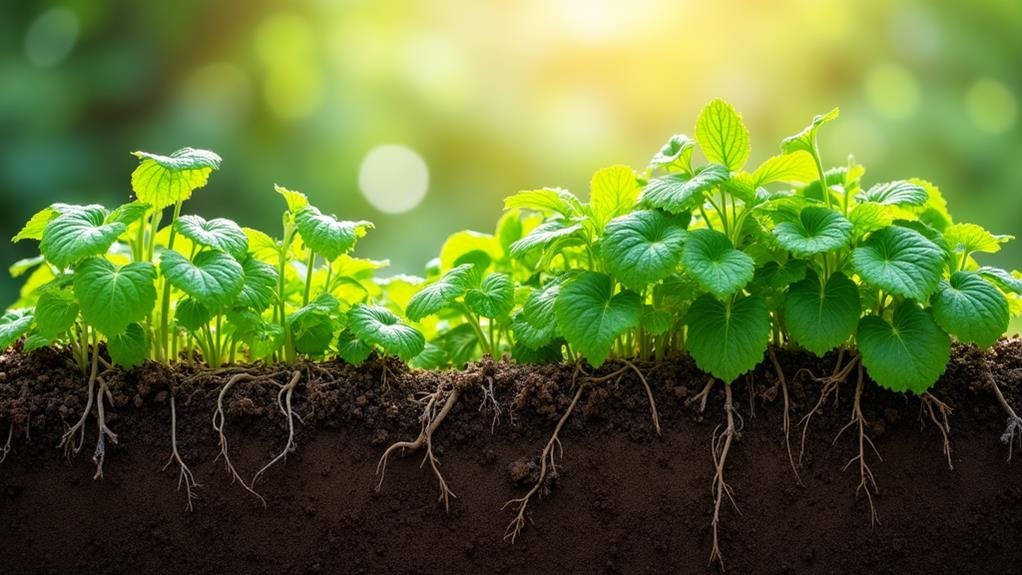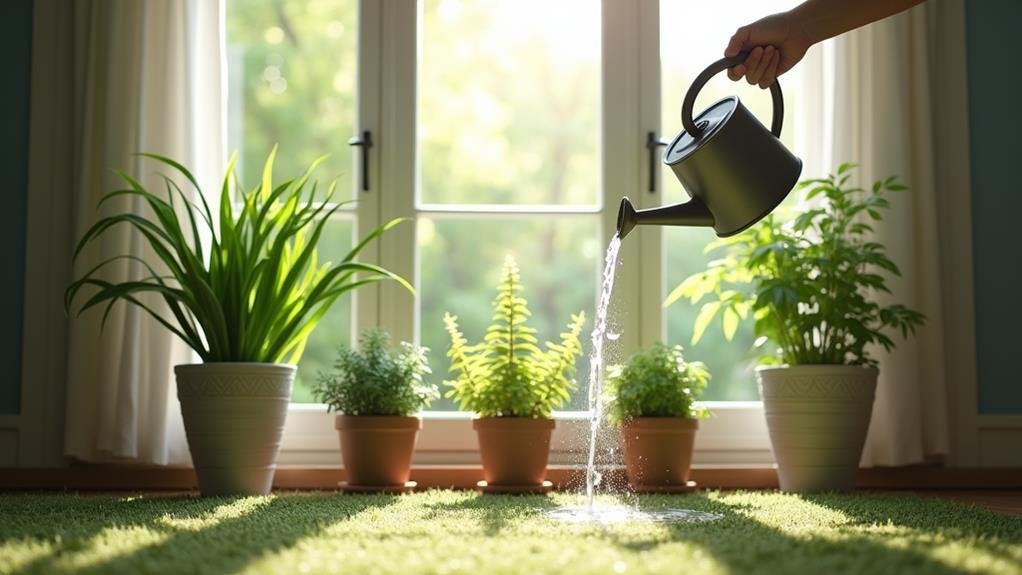When it pertains to deep watering your vegetable garden, understanding the specific needs of your plants is vital. You'll want to take into account soil composition and the moisture requirements of different vegetables to guarantee healthy growth. Techniques like using soaker hoses and mulching can greatly improve water retention. Timing your watering and adjusting based on weather conditions are just as important. But what are the best practices to implement these strategies effectively? Let's investigate some essential tips that can make a noticeable difference in your gardening success.
Understand Soil Composition
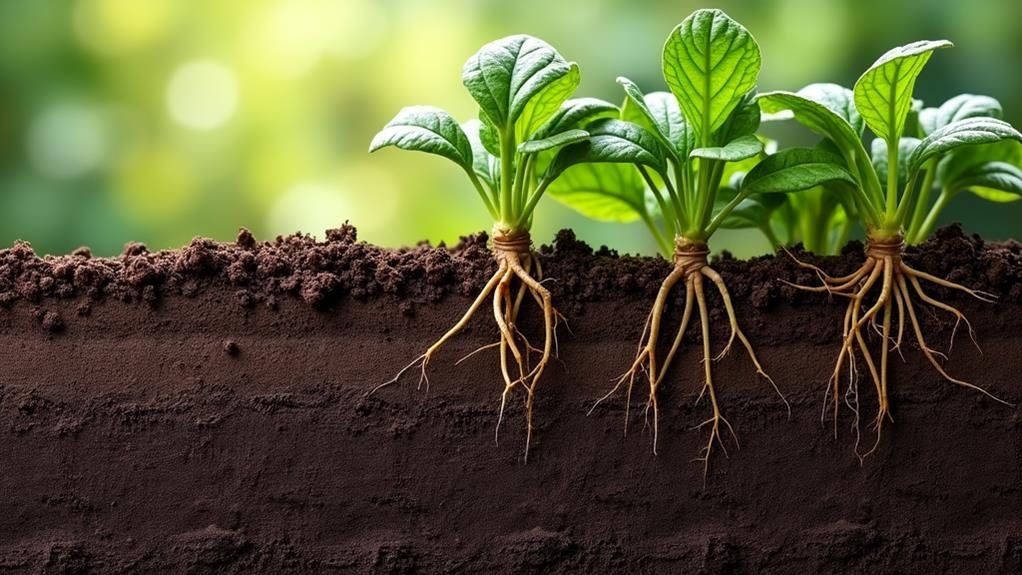
Soil composition plays an essential role in how well your vegetable garden thrives. Understanding what makes up your soil helps you create the perfect environment for your plants. Typically, soil consists of three main components: sand, silt, and clay. Sand provides drainage, silt holds nutrients, and clay retains moisture. The right balance among these elements is vital for healthy root growth.
You'll want to test your soil to determine its composition. A simple soil test kit can reveal the ratios of sand, silt, and clay. If your soil is too sandy, it might drain too quickly, leaving your plants thirsty. On the flip side, overly clayey soil can get waterlogged, suffocating roots.
Adding organic matter, like compost, can improve soil structure and nutrient content. It increases drainage while retaining moisture, creating a happy medium.
So, don't hesitate to amend your soil to achieve the right blend for your garden. Remember, healthy soil leads to healthy plants, and a thriving vegetable garden is just a well-balanced soil away.
Keep experimenting until you find what works best for you, and enjoy the fruits of your labor!
Determine Watering Frequency
Understanding how often to water your vegetable garden is essential for encouraging healthy growth. The frequency of watering depends on several factors, including soil type, weather conditions, and the specific needs of your plants.
Generally, you should aim to water deeply but less frequently, which promotes strong root development. A good rule of thumb is to water your garden once a week, providing about one to two inches of water each time.
However, during hot, dry spells, you might need to increase this frequency. Pay attention to the soil's moisture level; if the top inch feels dry, it's time to water.
For sandy soils, which drain quickly, you may need to water more often. In contrast, clay soils retain moisture longer, so you can space out your watering sessions.
Also, keep an eye on your plants; wilting or yellowing leaves often indicate that they need more water.
Time Your Watering Right
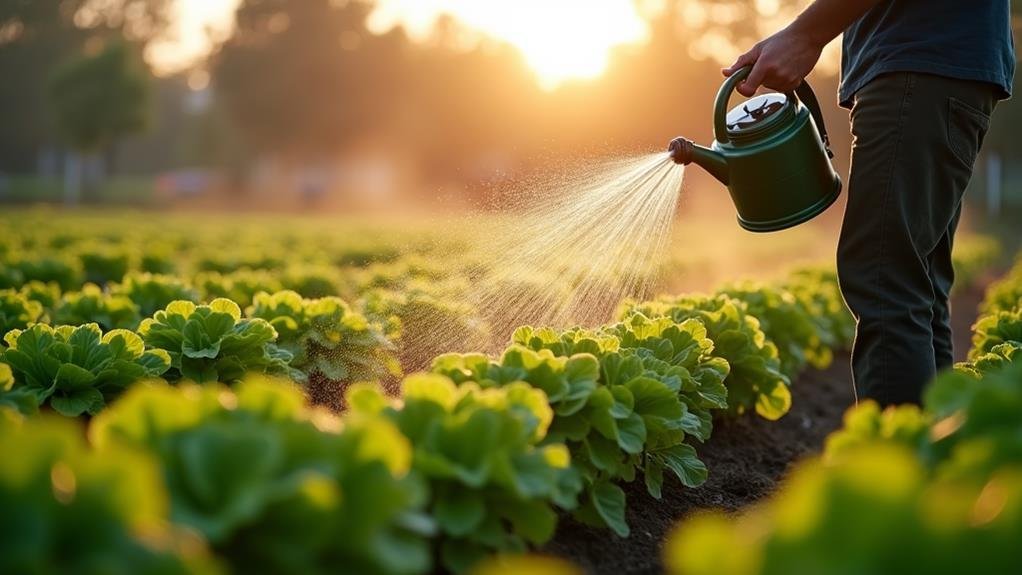
Timing your watering is essential for maximizing the benefits of deep watering. You'll want to water your vegetable garden early in the morning or late in the afternoon. During these cooler parts of the day, evaporation rates are lower, allowing more water to reach the roots where it's needed most. If you water during the hottest part of the day, you'll lose much of that precious moisture to the sun.
Avoid watering in the evening, though, as this can lead to excess moisture lingering overnight. This creates a breeding ground for diseases, which can harm your plants. Pay attention to the weather, too; if rain is in the forecast, skip your scheduled watering. A little rain can go a long way in keeping your plants hydrated.
Another factor to take into account is the growth stage of your plants. Seedlings and young plants may need more frequent watering, while established plants can often go longer between waterings.
Keeping an eye on the soil moisture will help you determine if it's time to water again. Remember, timing is key, and with practice, you'll find the perfect schedule for your garden's needs.
Use Soaker Hoses Effectively
When you want to guarantee your vegetable garden receives consistent moisture, using soaker hoses is a game changer. These hoses allow water to seep slowly into the soil, providing deep hydration directly to the roots.
To use them effectively, lay your soaker hoses throughout your garden beds, ensuring they're evenly spaced. This allows for uniform watering, preventing dry spots.
Before you start watering, check for any leaks and secure all connections. It's best to run your soaker hoses for about one to two hours, depending on your soil type and plant needs. Sandy soils may require more frequent watering, while clay soils may need less.
Don't forget to adjust your watering schedule based on the weather; a rainy week means you might skip a watering session.
For maximum effectiveness, cover your soaker hoses with mulch. This helps retain moisture and can improve their efficiency.
Remember to monitor your plants closely; if they look droopy, it might be time to tweak your watering routine. With a little practice, you'll find that soaker hoses can remarkably simplify your gardening efforts, helping you grow healthy, thriving vegetables.
Implement Mulching Techniques
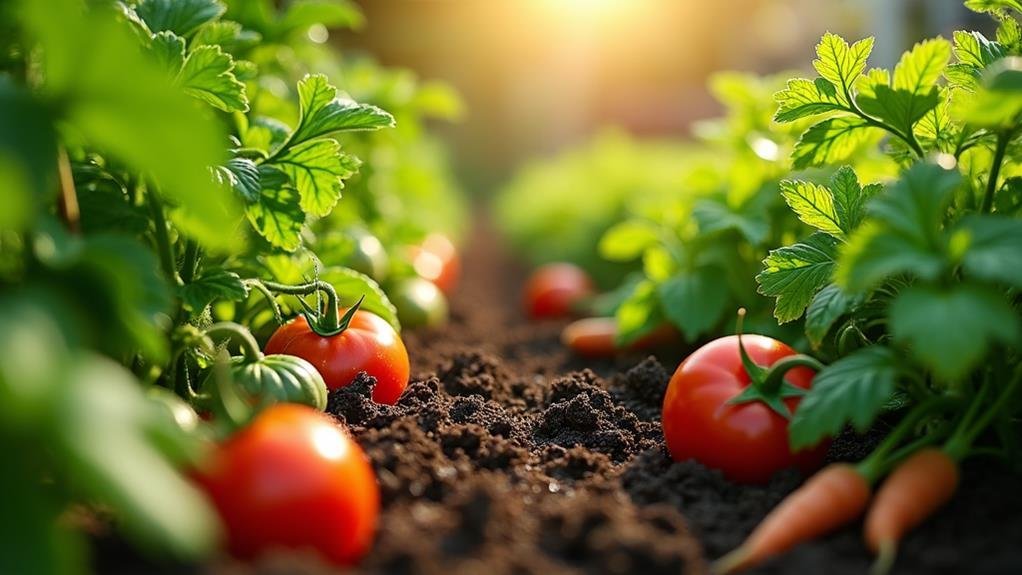
Implementing effective mulching techniques can greatly boost your vegetable garden's health and moisture retention. Mulch acts as a protective layer over the soil, helping to keep it cool and moist. You can choose organic materials like straw, wood chips, or shredded leaves, which will break down over time, enriching the soil with nutrients.
To apply mulch, start by removing any weeds from the area around your plants. Then, spread a layer of mulch about 2 to 4 inches thick, ensuring you keep it a few inches away from the plant stems to prevent rot. This thickness helps to suppress weeds, reducing competition for moisture and nutrients.
It's best to mulch after watering, so your soil stays damp longer. During hot weather, you might find it beneficial to refresh the mulch layer, as it can decompose or become compacted over time.
Monitor Soil Moisture Levels
After establishing a solid mulch layer, it's important to monitor soil moisture levels to verify your vegetables thrive. Regularly checking the moisture helps you understand how deep water penetrates and how much your plants actually need. You can do this by sticking your finger about an inch into the soil—if it feels dry, it's time to water.
Consider the weather conditions too. Hot, dry days will require more frequent checks compared to cooler, overcast ones. Rain can also impact your watering schedule, so keep an eye on the forecast.
Using a moisture meter can simplify this process. These devices provide a quick and accurate reading of the soil's moisture content, helping you avoid under or over-watering.
Remember, different vegetables have varying moisture requirements; leafy greens often need more water than root vegetables.
Lastly, pay attention to your plants. Wilting leaves or yellowing can signal that they're not getting enough moisture.
Choose the Right Tools

To guarantee your deep watering efforts are effective, choosing the right tools is essential.
Start with a quality garden hose that's long enough to reach all corners of your garden. A soaker hose is a fantastic option; it delivers water directly to the soil, minimizing evaporation and ensuring deep penetration.
If you prefer a more targeted approach, consider a drip irrigation system. It's efficient, allowing you to control water flow and timing.
Don't overlook the importance of watering cans, especially for smaller plants or tight spaces. A watering can with a long spout makes it easier to direct water exactly where it's needed.
Additionally, invest in a moisture meter. This handy tool helps you monitor soil moisture levels, ensuring you're not over or under-watering.
Create Watering Zones
Creating distinct watering zones in your vegetable garden can greatly improve the efficiency of your deep watering strategy.
Start by evaluating the layout of your garden. Group plants with similar water needs together, ensuring you can cater to their specific requirements without wasting water. For instance, leafy greens might need more moisture than root vegetables, so placing them in separate zones makes sense.
Next, consider the sun exposure each zone receives. Sunny areas tend to dry out quicker, while shaded spots retain moisture longer. By establishing zones based on sunlight, you can adjust your watering frequency accordingly.
Using markers or garden stakes can help you easily identify these zones. When you water, focus on each zone individually, allowing water to penetrate deeply into the soil. This encourages stronger root growth and reduces the risk of overwatering certain areas.
Don't forget to observe how each zone responds over time. You might find that some areas need more attention than others, and adjusting your strategy will keep your garden thriving.
With a little planning, you'll create a well-organized watering system that promotes healthy, robust vegetables. Happy gardening!
Adjust for Weather Conditions

In regard to deep watering your vegetable garden, adjusting for weather conditions is essential. If it's been particularly hot and dry, your plants might need more frequent watering to guarantee they're getting enough moisture.
On the flip side, during rainy periods, you may want to cut back on your watering schedule to prevent over-saturation.
Pay attention to the forecast. If you know rain is on the way, you can skip watering for a day or two, allowing nature to lend a hand.
Conversely, if a heatwave is approaching, consider increasing the amount of water you provide, focusing on deep watering to promote strong root development.
You should also consider wind conditions. Strong winds can dry out the soil faster, so you might need to water more often during gusty days.
Observe Plant Responses
Observing your plants closely can reveal a lot about their watering needs. As you tend to your vegetable garden, pay attention to any signs of stress. Wilted leaves or drooping stems are often cries for help, indicating that your plants might be thirsty.
On the other hand, yellowing leaves can signal overwatering, which can lead to root rot.
Check the soil moisture regularly by sticking your finger into the ground. If it feels dry an inch or two down, it's time to water. If it's still moist, hold off for a day or two.
Keep an eye on the overall growth and vigor of your plants, too. Healthy plants should have vibrant, green leaves and sturdy stems.
Also, look for any pests or diseases that may be affecting their health. A well-hydrated plant is more resilient against these threats.
Finally, consider your plants' growth phase; seedlings need different moisture levels compared to mature plants.
Conclusion
By following these tips for deep watering your vegetable garden, you can promote healthier plants and better yields. Remember to understand your soil's needs, time your watering wisely, and use tools like soaker hoses effectively. Keep an eye on your plants and adjust your methods based on their responses and weather changes. With a little attention and care, you'll cultivate a thriving garden that's the envy of your neighbors—without drowning your veggies! It’s also important to remember that different vegetables may have different watering needs, so be sure to research each specific plant in your garden. In addition to outdoor gardening, it’s also important to consider indoor plant watering tips to ensure your houseplants stay healthy and vibrant. By following these simple tips and staying attentive to your garden’s needs, you can ensure a bountiful harvest and a beautiful indoor oasis.


